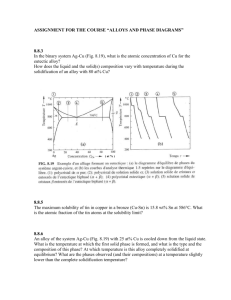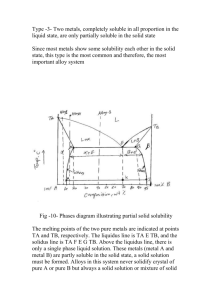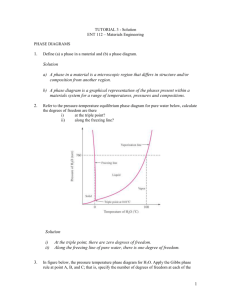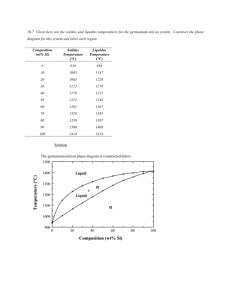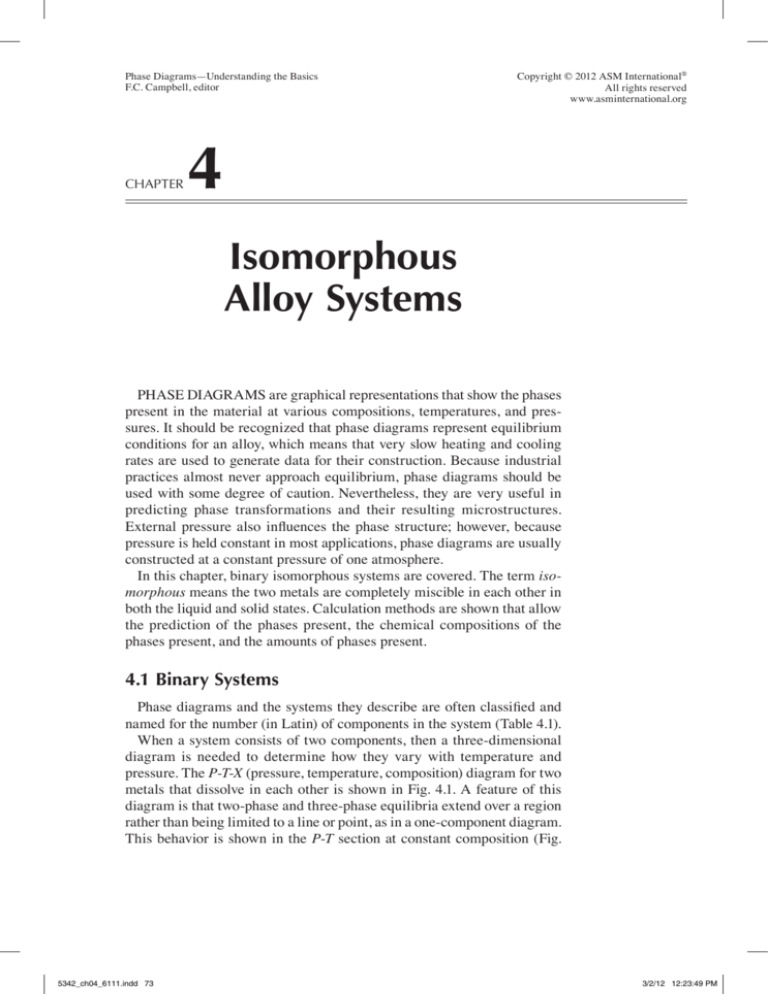
Phase Diagrams—Understanding the Basics
F.C. Campbell, editor
Chapter
Copyright © 2012 ASM International®
All rights reserved
www.asminternational.org
4
Isomorphous
Alloy Systems
Phase diagrams are graphical representations that show the phases
present in the material at various compositions, temperatures, and pressures. It should be recognized that phase diagrams represent equilibrium
conditions for an alloy, which means that very slow heating and cooling
rates are used to generate data for their construction. Because industrial
practices almost never approach equilibrium, phase diagrams should be
used with some degree of caution. Nevertheless, they are very useful in
predicting phase transformations and their resulting microstructures.
External pressure also influences the phase structure; however, because
pressure is held constant in most applications, phase diagrams are usually
constructed at a constant pressure of one atmosphere.
In this chapter, binary isomorphous systems are covered. The term isomorphous means the two metals are completely miscible in each other in
both the liquid and solid states. Calculation methods are shown that allow
the prediction of the phases present, the chemical compositions of the
phases present, and the amounts of phases present.
4.1 Binary Systems
Phase diagrams and the systems they describe are often classified and
named for the number (in Latin) of components in the system (Table 4.1).
When a system consists of two components, then a three-dimensional
diagram is needed to determine how they vary with temperature and
pressure. The P-T-X (pressure, temperature, composition) diagram for two
metals that dissolve in each other is shown in Fig. 4.1. A feature of this
diagram is that two-phase and three-phase equilibria extend over a region
rather than being limited to a line or point, as in a one-component diagram.
This behavior is shown in the P-T section at constant composition (Fig.
5342_ch04_6111.indd 73
3/2/12 12:23:49 PM
74 / Phase Diagrams—Understanding the Basics
Table 4.1 Number of components
Number of components
One
Two
Three
Four
Five
Six
Seven
Eight
Nine
Ten
Source: Ref 4.1
Name of system or diagram
Unary
Binary
Ternary
Quarternary
Quinary
Sexinary
Septenary
Octanary
Nonary
Decinary
Fig. 4.1 P-T-X diagram for two metals, A and B, that dissolve completely in
each other in the liquid and solid states. (a) The P-T-X diagram. (b)
A P-T section at the 50% B composition. (c) A P-X section below the triple point
of both pure metals. (d) A T-X section at atmospheric pressure. P, pressure. T,
temperature. X, composition. Adapted from Ref 4.2
5342_ch04_6111.indd 74
3/2/12 12:23:50 PM
Chapter 4: Isomorphous Alloy Systems / 75
4.1b). It is often useful to have a section at constant temperature through
the P-T-X diagram. A P-X section of this kind is shown in Fig. 4.1(c) for a
temperature below the triple points of both metals. By far the most useful
section through the P-T-X diagram is the one at constant pressure, at atmospheric pressure in particular. Figure 4.1(d) shows the diagram obtained in
this instance. Therefore, the most commonly encountered phase diagram in
metallurgy is a T-X diagram constructed at a pressure of one atmosphere.
The Gibbs phase rule applies to all states of matter (solid, liquid, and
gaseous), but when the effect of pressure is constant, the rule reduces to:
F=C–P+1
The stable equilibria for binary systems are summarized in Table 4.2.
The areas (fields) in a phase diagram, and the position and shapes of the
points, lines, surfaces, and intersections in it, are controlled by thermodynamic principles and the thermodynamic properties of all of the phases
that constitute the system. The phase field rule specifies that at constant
temperature and pressure, the number of phases in adjacent fields in a
multicomponent diagram must differ by one.
4.1.1 Binary Isomorphous Systems
Some systems are comprised of components having the same crystal
structure, and the components of some of these systems are completely
miscible (completely soluble in each other) in the solid form, thus forming
a continuous solid solution. When this occurs in a binary system, the phase
diagram usually has the general appearance of that shown in Fig. 4.2. The
diagram consists of two single-phase fields separated by a two-phase field.
The boundary between the liquid field and the two-phase field in Fig. 4.2 is
called the liquidus; that between the two-phase field and the solid field is
the solidus. In general, a liquidus is the locus of points in a phase diagram
representing the temperatures at which alloys of the various compositions
of the system begin to freeze on cooling or finish melting on heating; a
solidus is the locus of points representing the temperatures at which the
various alloys finish freezing on cooling or begin melting on heating. The
phases in equilibrium across the two-phase field in Fig. 4.2 (the liquid and
solid solutions) are called conjugate phases.
Table 4.2 Stable equilibria for binary systems
Number of components
Number of phases
Degrees of freedom
Equilibrium
2
2
2
3
2
1
0
1
2
Invariant
Univariant
Bivariant
Source: Ref 4.1
5342_ch04_6111.indd 75
3/2/12 12:23:50 PM
76 / Phase Diagrams—Understanding the Basics
Fig. 4.2 Schematic binary phase diagram showing miscibility in both the
liquid and solid states. Source: Ref 4.1
Consider briefly how these diagrams are constructed. A pure metal will
solidify at a constant temperature, while an alloy will solidify over a temperature range that depends on the alloy composition. Consider the series
of cooling curves for the copper-nickel system (Fig. 4.3). For increasing
amounts of nickel in the alloy, freezing begins at increasing temperatures
A, A1, A2, A3, up to pure nickel at A4, and finishes at increasing temperatures B, B1, B2, B3, up to pure nickel at B4. If the points A, A1, A2, A3, and A4
are joined, the result is the liquidus line, which indicates the temperature
at which any given alloy will begin to solidify. Likewise, by joining the
points B, B1, B2, B3, and B4, the solidus line, the temperature at which any
given alloy will become completely solid, is obtained. In other words, at
all temperatures above the liquidus, the alloy will be a liquid, and at all
temperatures below the solidus, the alloy will be a solid. At temperatures
between the liquidus and the solidus, sometimes referred to as the “mushy
zone,” both liquid and solid coexist in equilibrium.
Very simple phase diagrams of this type can be constructed by using the
appropriate points obtained from time-temperature cooling curves, which
indicate where freezing began and where it was complete. However, if the
alloy system is one in which further structural changes occur after the
alloy has solidified, then the metallurgist must resort to other methods of
investigation to determine the phase-boundary lines. These techniques are
described in Chapter 12, “Phase Diagram Determination,” in this book.
5342_ch04_6111.indd 76
3/2/12 12:23:50 PM
Chapter 4: Isomorphous Alloy Systems / 77
Fig. 4.3 Phase diagram construction from cooling curves. Source: Ref 4.3
A few systems consist of components having the same crystalline structure, and the components of some of these systems are completely soluble,
or miscible, in each other in the liquid and solid form, thus forming a
continuous series of solid solutions. When this occurs in a binary system,
the phase diagram usually has the general appearance of that in the coppernickel system shown in Fig. 4.4. Temperature is plotted along the ordinate
axis, and the alloy composition is shown on the abscissa axis. The composition ranges from 0 wt% Ni (100 wt% Cu) on the extreme left to 100
wt% Ni (0 wt% Cu) on the extreme right. Three different phase regions,
or fields, are present on the diagram: a liquid (L) field, a two-phase solid
plus liquid field (α + L), and a solid-solution alpha (α) field, where α is a
solid solution containing both copper and nickel. Each field is defined by
the phase or phases that exist over the range of temperatures and compositions bounded by the phase-boundary lines. At high temperatures, the
liquid, L, field is a homogenous liquid solution composed of both copper
and nickel. The solid solution, α, that exists at lower temperatures is a
substitutional solid solution consisting of both copper and nickel atoms
with a face-centered cubic (fcc) crystalline structure. When an alloy of any
given composition freezes, copper and nickel are mutually soluble in each
other and therefore display complete solid solubility. Solid solutions are
commonly designated by lowercase Greek letters. The boundaries between
the regions are identified as the liquidus and solidus. The upper curve separating the liquid, L, and the two-phase, L + α, field is termed the liquidus
line. The liquidus is the lowest temperature at which any given composition can be found in an entirely molten state. The lower curve separating
the solid solution, α, field and the two-phase, L + α, field is known as the
solidus line. The solidus is the highest temperature when all atoms of a
given composition can be found in an entirely solid state. A solidus is the
locus of points representing the temperatures at which the various alloys
finish freezing on cooling or begin melting on heating.
5342_ch04_6111.indd 77
3/2/12 12:23:51 PM
78 / Phase Diagrams—Understanding the Basics
Fig. 4.4 Copper-nickel phase diagram. Source: Ref 4.3
Complete solid solubility is actually the exception rather than the rule.
To obtain complete solubility, the system must adhere to the Hume-Rothery rules for solid solutions (see Chapter 2, “Solid Solutions and Phase
Transformation,” in this book). In this case, both copper and nickel have
the fcc crystal structure, have nearly identical atomic radii and electronegativities, and have similar valences. The term isomorphous implies
complete solubility in both the liquid and solid states. Most alloys do not
have such simple phase systems. Typically, alloying elements have significant differences in their atomic size and crystalline structure, and the
mismatch forces the formation of a new crystal phase that can more easily
accommodate alloying elements in the solid state.
5342_ch04_6111.indd 78
3/2/12 12:23:51 PM
Chapter 4: Isomorphous Alloy Systems / 79
The liquidus and solidus lines intersect at the two composition extremities; that is, at the temperatures corresponding to the melting points of
pure copper (1085 °C, or 1981 °F) and pure nickel (1455 °C, or 2644 °F).
Because pure metals melt at a constant temperature, pure copper remains a
solid until its melting point of 1085 °C (1981 °F) is reached on heating. The
solid-to-liquid transformation then occurs and no further heating is possible until the transformation is complete. However, for any composition
other than the pure components, melting will occur over a range of temperatures between the solidus and liquidus lines. For example, on heating a
composition of 50wt%Cu-50wt%Ni, melting begins at approximately 1250
°C (2280 °F) and the amount of liquid increases until approximately 1315
°C (2400° F) is reached, at which point the alloy is completely liquid.
A binary phase diagram can be used to determine three important types
of information: (1) the phases that are present, (2) the composition of the
phases, and (3) the percentages or fractions of the phases.
Prediction of Phases. The phases that are present can be determined
by locating the temperature-composition point on the diagram and noting
the phase(s) present in the corresponding phase field. For example, an alloy
of composition 30wt%Ni-70wt%Cu at 1315 °C (2400 °F) would be located
at point a in Fig. 4.4. Because this point lies totally within the liquid field,
the alloy would be a liquid. The same alloy at 1095 °C (2000 °F), designated point c, is within the solid solution, α, field, only the single α phase
would be present. On the other hand, a 30wt%Ni-70wt%Cu alloy at 1190
°C (2170 °F) (point b) would consist of a two-phase mixture of solid solution, α, and liquid, L.
Prediction of Chemical Compositions of Phases. To determine the
composition of the phases present, locate the point on the phase diagram.
If only one phase is present, the composition of the phase is the overall
composition of the alloy. For example, for an alloy of 30wt%Ni-70wt%Cu
at 1095 °C (2000 °F) (point c in Fig. 4.4), only the α phase is present, and
the composition is 30wt%Ni-70wt%Cu. For an alloy with composition and
temperature coordinates located in a two-phase region, the compositions
of the phases can be determined by drawing a horizontal line, referred
to as a tie line, between the two phase boundaries at the temperature of
interest. Then, drop perpendicular lines from the intersections of each
boundary down to the composition axis and read the compositions. For
example, again considering the 30wt%Ni-70wt%Cu alloy at 1190 °C (2170
°F) located at point b in Fig. 4.4 and lying with the two-phase, α + L, field.
The perpendicular line from the liquidus boundary to the composition
axis is 20wt%Ni-80wt%Cu, which is the composition, CL, of the liquid
phase. In a similar manner, the composition of the solid-solution phase,
Cα, is read from the perpendicular line from the solidus line down to the
composition axis, in this case 35wt%Ni-65wt%Cu.
5342_ch04_6111.indd 79
3/2/12 12:23:51 PM
80 / Phase Diagrams—Understanding the Basics
Prediction of Amounts of Phases. The percentages or fractions of
the phases present at equilibrium can also be determined with phase diagrams. In a single-phase region, because only one phase is present, the
alloy is comprised entirely of that phase; that is, the phase fraction is 1.0
and the percentage is 100%. From the previous example for the 30wt%Ni70wt%Cu alloy at 1095 °C (2000 °F) (point c in Fig. 4.4), only the α phase
is present and the alloy is 100% α.
If the composition and temperature position is located within a twophase field, a horizontal tie line must be used in conjunction with the lever
rule. The lever rule is a mathematical expression based on the principle
of conservation of matter. First, a tie line is drawn across the two-phase
region at the composition and temperature of the alloy. The fraction of one
phase is determined by taking the length of the tie line from the overall
alloy composition to the phase boundary for the other phase and dividing by the total tie line length. The fraction of the other phase is then
determined in the same manner. If phase percentages are desired, each
phase fraction is multiplied by 100. When the composition axis is scaled
in weight percent, the phase fractions computed using the lever rule are
mass fractions—the mass (or weight) of a specific phase divided by the
total alloy mass (or weight). The mass of each phase is computed from the
product of each phase fraction and the total alloy mass.
Again, consider the 30wt%Ni-70wt%Cu alloy at 1190 °C (2170 °F)
located at point b in Fig. 4.4 containing both the solid, α, and the liquid,
L, phases. The same tie line that was used for determination of the phase
compositions can again be used for the lever rule calculation. The overall
alloy composition located along the tie line is Cα – CL or 35 – 20 wt%. The
weight percentage of liquid present is then:
wt% L =
Ca − Co 35 − 30
=
≈ 0.33, or 33%
Ca − C L 35 − 20
Likewise, the amount of solid present is:
wt% S =
Co − C L 30 − 20
=
≈ 0.67, or 67%
Ca − C L 35 − 20
Because graphical methods are used to perform these calculations, the
results are approximate rather than exact. The lever rule, or more appropriately, the inverse lever rule, can be visualized as a scale, such as the one
shown in Fig. 4.5. For the scale to balance, the weight percentage of the
liquid, which is less, must have the longer lever arm, in this instance 10
units, compared to the solid phase, α, which has a higher weight percentage and thus a shorter lever arm of 5 units.
5342_ch04_6111.indd 80
3/2/12 12:23:52 PM
Chapter 4: Isomorphous Alloy Systems / 81
Fig. 4.5 Visual representation of lever rule. Source: Ref 4.2 as published in
Ref 4.3
It is important to emphasize that equilibrium phase diagrams identify
phase changes under conditions of very slow changes in temperature. In
practical situations, where heating and cooling occur more rapidly, the
atoms do not have enough time to get into their equilibrium positions,
and the transformations may start or end at temperatures different from
those shown on the equilibrium phase diagrams. In these practical circumstances, the actual temperature at which the phase transformation occurs
will depend on both the rate and direction of temperature change. Nevertheless, phase diagrams provide valuable information in virtually all metal
processing operations that involve heating the metal, such as casting, hot
working, and all heat treatments.
The copper-nickel system is an example of solid-solution hardening or
strengthening. Most of the property changes in a solid-solution system are
caused by distortion of the crystalline lattice of the base or solvent metal
by additions of the solute metal. The distortion increases with the amount
of the solute metal added, and the maximum effect occurs near the center
of the diagram, because either metal can be considered as the solvent. As
shown in Fig. 4.6, the strength curve passes through a maximum, while
the ductility curve, as measured by percent elongation, passes through a
minimum. Properties that are almost unaffected by atom interactions vary
more linearly with composition. Examples include the lattice constant,
thermal expansion, specific heat, and specific volume.
Copper-nickel alloys have a good combination of properties and corrosion resistance. One of the most notable uses is for clad coinage. A Cu-25%
Ni alloy is used for the clad coinage of the U.S. dime, quarter, and halfdollar. The coins contain a copper core that is clad on the surfaces with the
copper-nickel alloy (Fig. 4.7). The same alloy is used for the U.S. nickel.
5342_ch04_6111.indd 81
3/2/12 12:23:52 PM
82 / Phase Diagrams—Understanding the Basics
Fig. 4.6 Typical property variations in copper-nickel system. Source: Ref 4.2
as published in Ref 4.3
If the solidus and liquids meet tangentially at some point, a maximum or
minimum is produced in the two-phase field, splitting it into two portions
(Fig. 4.8). It also is possible to have a gap in miscibility in a single-phase
field (Fig. 4.9). Point Tc, above which phases α1 and α2 become indistinguishable, is a critical point. Lines a-Tc and b-Tc, called solvus lines, indicate
the limits of solubility of component B in A and A in B, respectively.
5342_ch04_6111.indd 82
3/2/12 12:23:52 PM
Chapter 4: Isomorphous Alloy Systems / 83
Fig. 4.7 Copper-nickel clad coinage construction. Source: Ref 4.4
Fig. 4.8 Schematic binary phase diagrams with solid-state miscibility where the liquidus shows (a) a
maximum and (b) a minimum. Source: Ref 4.1
Fig. 4.9 Schematic binary phase diagram with a minimum in the liquidus and
a miscibility gap in the solid state. Source: Ref 4.1
5342_ch04_6111.indd 83
3/2/12 12:23:53 PM
84 / Phase Diagrams—Understanding the Basics
Fig. 4.10 Coring due to nonequilibrium solidification. Source: Ref 4.5 as published in Ref 4.3
5342_ch04_6111.indd 84
3/2/12 12:23:54 PM
Chapter 4: Isomorphous Alloy Systems / 85
4.2 Nonequilibrium Cooling
As previously mentioned, equilibrium phase diagrams are constructed to
reflect extremely slow cooling rates that approach equilibrium conditions.
This type of cooling is seldom encountered in industrial practice where
faster cooling rates can produce segregation in the solidification products.
As an example of a type of segregation called coring, produced by nonequilibrium freezing, consider the 70% Ni-30% Cu alloy in Fig. 4.10 that is
rapidly cooled from a temperature, T0. The first solid forms at temperature
T1 with a composition of α1. On further rapid cooling to T2, additional layers of composition, α2, form. The overall composition at T2 lies somewhere
between α1 and α2 and is designated as α¢2. Because the tie line at α¢2 L2
is longer than α2 L2, there will be more liquid and less solid in the rapidly
cooled alloy than if it had been slowly cooled under equilibrium conditions. As rapid cooling continues through T3 and T4, the same processes
occur, and the average composition follows the nonequilibrium solidus
determined by points α1, α¢2, α¢3, º. At T7, freezing is complete and the
average composition of the alloy is 30% Cu. The microstructure consists
of regions varying from α1 to α¢7, producing a cored microstructure.
REFERENCES
4.1H. Baker, Introduction to Alloy Phase Diagrams, Phase Diagrams,
Vol 3, ASM Handbook, ASM International, 1992, reprinted in Desk
Handbook: Phase Diagrams for Binary Alloys, 2nd ed., H. Okamoto,
Ed., ASM International, 2010
4.2 A.G. Guy, Elements of Physical Metallurgy, 2nd ed., Addison-Wesley
Publishing Company, 1959
4.3 F.C. Campbell, Elements of Metallurgy and Engineering Alloys,
ASM International, 2008
4.4 Microstructure of Copper and Copper Alloys, Atlas of Microstructures of Industrial Alloys, Vol 7, Metals Handbook, 8th ed., American
Society for Metals, 1972
4.5 V. Singh, Physical Metallurgy, Standard Publishers Distributors,
1999
5342_ch04_6111.indd 85
3/2/12 12:23:54 PM
5342_ch04_6111.indd 86
3/2/12 12:23:54 PM

